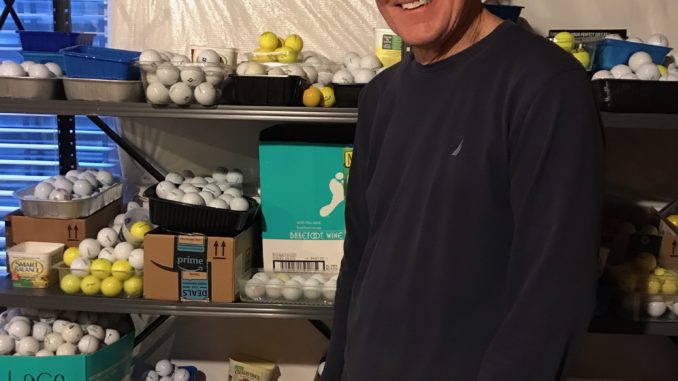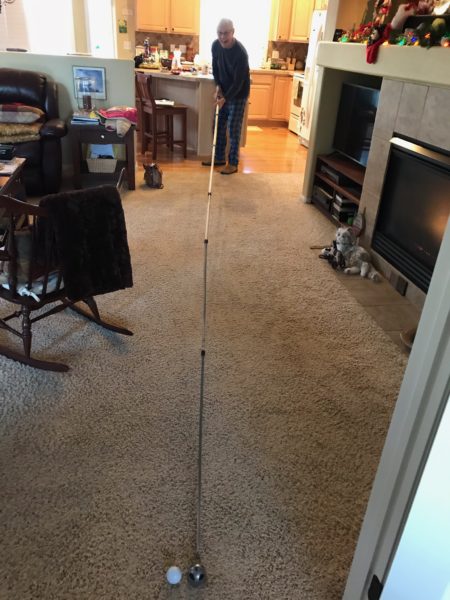
by Libby James
photos by Libby James
The desire to collect runs deep in Bob Sullivan’s DNA. His dad collected matchbook covers, stamps, coins, and baseball cards. Since his middle school years when he learned the fundamentals of golf, his favorite game, Sullivan has searched for and collected between 35 and 40 thousand golf balls.
His high school teacher, coach, and golf pro at the Dwight, Illinois golf club, hired him to man the caddy shack and mow greens when he was in middle school. It was then that he began to retrieve golf balls from the creek that meandered through the golf course. He sold “cut” balls for five cents, named balls brought 10 cents and really good balls, Sullivan sold for 15 cents. In addition to providing him with pocket money, his job came with a membership to the club.
Now 78, Sullivan retired 16 years ago from a career as a college administrator and English/math professor at Aims Community College. Since that time his hobby has evolved into a fine art. “I’ve always loved to fish,” Sullivan says by way of explaining his passion. “I’m analytical and have lots of patience,” he says, explaining these traits as why fishing and golf ball collecting are both so satisfying for him.

Golf balls are everywhere in the home he shares with wife Pat in Erie, Colorado. Pat is not only a golfer, but also joins him on collecting expeditions. Over time he has learned that the best balls are to be found a least 200 yards from a tee, where the better golfers are more likely to shoot. Other balls can be found anywhere, usually shorter distances from the tee.
A bad weather day when golfers are not out is a good day to hunt, Sullivan says. He uses a golf ball retriever that expands to 18 feet to snag balls that are out of his reach. He can collect 400 to 500 balls in a single outing. Often during his hunts, he comes across strange pieces of bone which he places in a spot in his yard dubbed the boneyard.
Collecting the balls is only the beginning. Step one in processing involves placing 80 balls at a time, along with several big beach towels, in his washing machine and sending them through the cycle. No. They don’t go into the dryer.
At this point, he wipes the balls dry and examines each one. Some emerge clean and unmarked and need no further treatment. Others he sets aside to scrub with a scratchy pad and scour with acetone to remove unwanted markings. Once processed, the balls are organized on his basement shelves by brand, from Bridgestone to Wilson, they are ready to begin their second life.
He donates golf balls to Goodwill and the Salvation Army. He gives balls to his golfing buddies, to coaches and high school golf teams. He keeps five to seven thousand in stock, for his own use, to give as prizes in tournaments, and for informal competitions with golfing friends.
Why does Sullivan devote so much time and effort to this unusual hobby? “The expenses are minimal,” he says. “I never know what the next ‘catch’ will be. It provides me with lots of fresh air and exercise. It’s a conversation starter. It nurtures my mind and analytical nature. It is a great escape from the never-ending home ‘to do’ list. My wife Pat says, ‘Do what will make you feel best.’ So often, that’s what I do.”
Support Northern Colorado Journalism
Show your support for North Forty News by helping us produce more content. It's a kind and simple gesture that will help us continue to bring more content to you.
BONUS - Donors get a link in their receipt to sign up for our once-per-week instant text messaging alert. Get your e-copy of North Forty News the moment it is released!
Click to Donate
